Edmontosaurus has been a staple in dinosaur toy lines since the very beginning of dinosaur toy production with Marx in the 1950’s. It’s a quintessential dinosaur, right up there with Triceratops, T. rex, and Stegosaurus, even if it was historically regarded as nothing more than theropod fodder. Although I have a few Edmontosaurus sitting around in my own collection, I was sorely in need of a more modern take on this classic dinosaur, with my most recent addition being the 2010 Safari Edmontosaurus! Where has the time gone? Unfortunately, I didn’t care for Safari or CollectA’s most recent versions of the genus, so I skipped them and patiently waited for what the future had in store. I’m glad I did, because earlier this year I was presented with two options that met my criteria for what I wanted in an Edmontosaurus. Not surprisingly, they were from PNSO and Haolonggood. Two companies that have been pitted against each other on a few occasions this past year. Obviously if you’re reading this review, you know which one I chose, so let’s get into it and see if I made the right choice with Haolonggood’s Edmontosaurus.
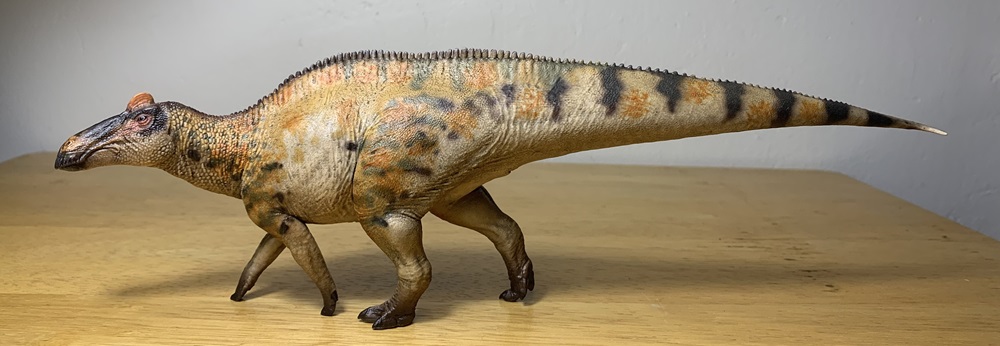
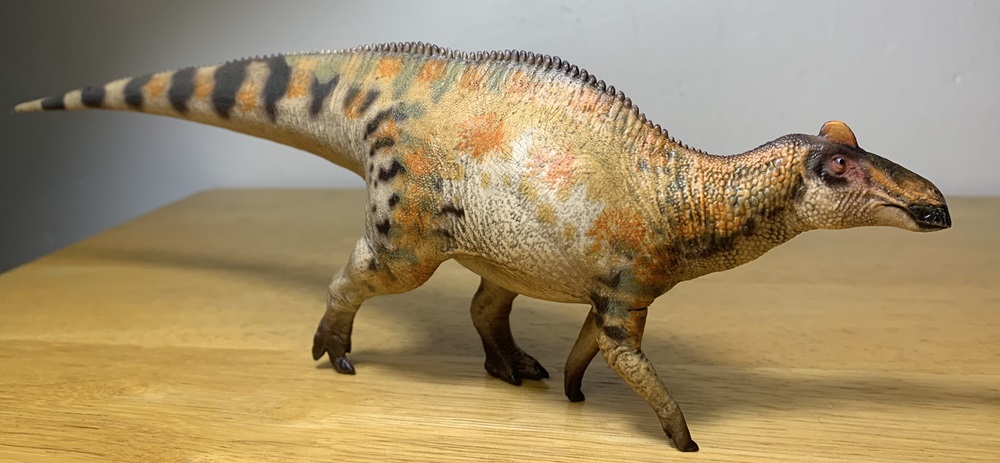
First off, we need to discuss the two species of Edmontosaurus and which one Haolonggood’s is, because this is evidently important to collectors. Most Edmontosaurus figures represent E. regalis. This species lived 73-70 million years ago and is mostly associated with the Horseshoe Canyon Formation in Alberta. It would have lived alongside the likes of Edmontonia, Pachyrhinosaurus, Euoplocephalus, and Albertosaurus. A single specimen of E. regalis was preserved with a fleshy cockscomb on top of its head and this feature is now included in most E. regalis reconstructions.

The other species is E. annectens, which would have lived 68-66 million years ago at the end of the Mesozoic. It is notable for having been found in the Hell Creek formation and would have lived alongside Tyrannosaurus, Triceratops, and Ankylosaurus. Both Edmontosaurus species were among the largest ornithopods, reaching lengths between 30-40’ (9-12 meters). No comb is known for E. annectens currently.
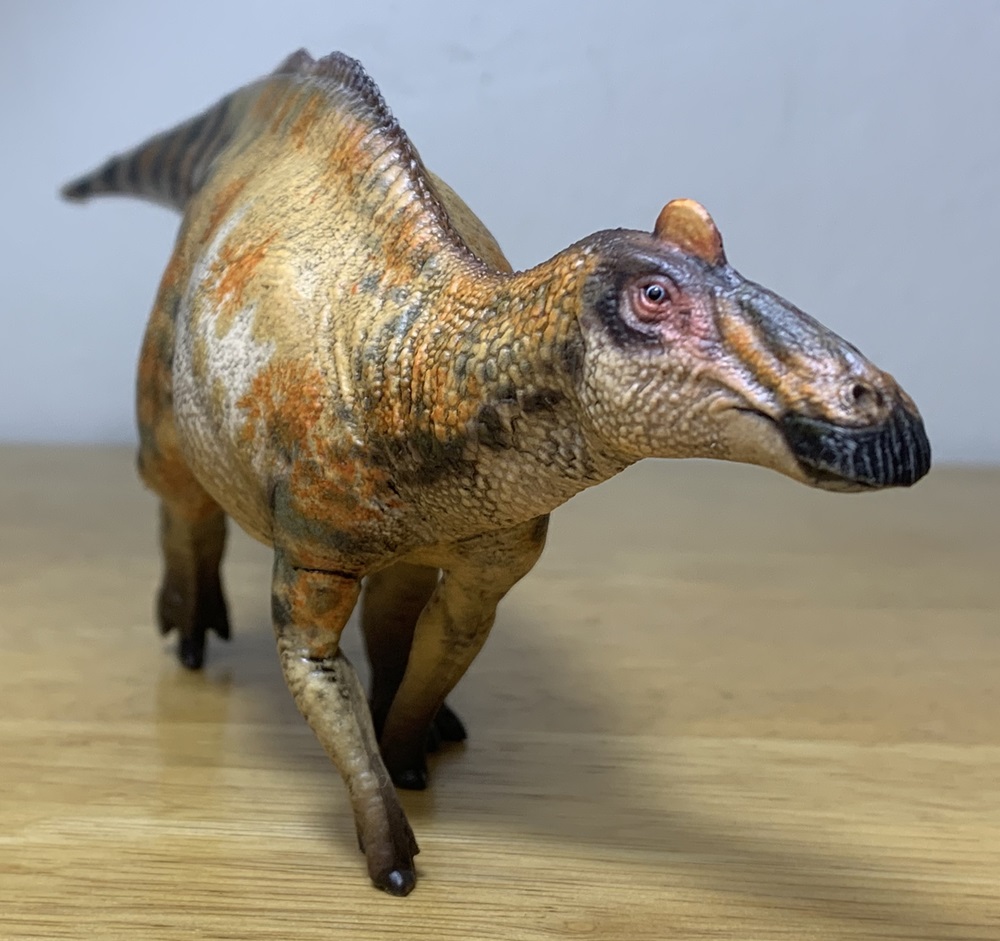
In addition to the comb, the most obvious difference lies in the skull shapes, with E. annectens having a long, low, less robust skull than E. regalis. The comb alone would suggest that Haolonggood’s Edmontosaurus is E. regalis, but the skull shape is a closer match for that species as well.
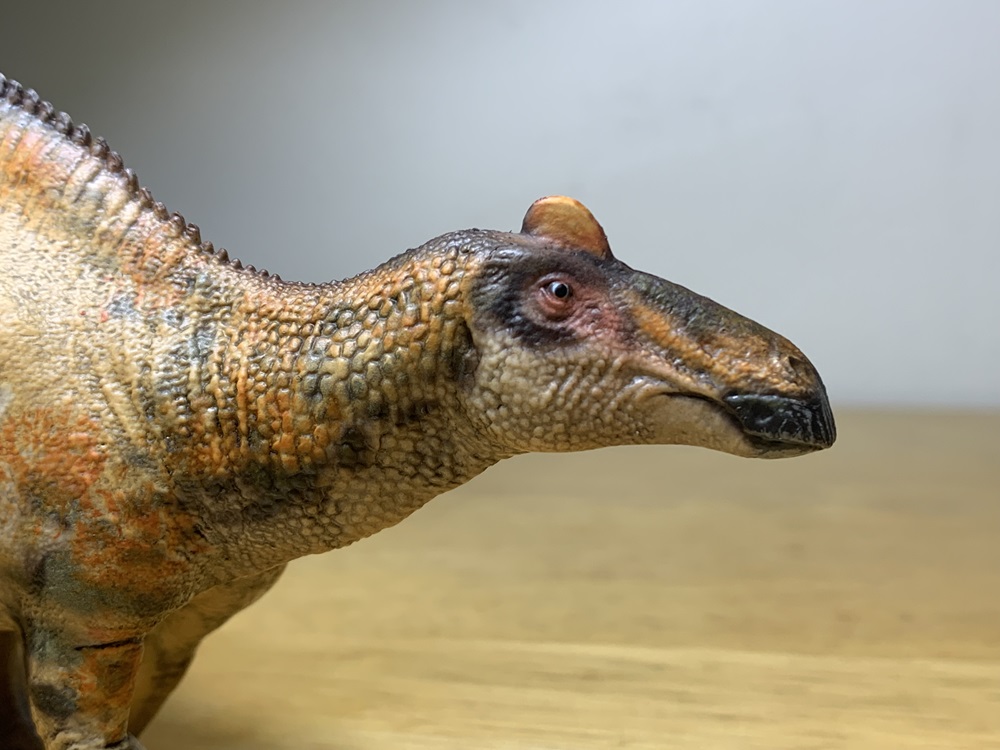
The identity of this and PNSO’s Edmontosaurus have been heavily debated online with no clear consensus, which to me means it isn’t worth losing sleep over. The presence of a crest on one specimen of E. regalis doesn’t mean that E. annectens didn’t have one, or that it wasn’t a sex-specific characteristic for one or both species! Also, looking at skulls for both species, it becomes clear that there is a degree of overlap in appearance and much individual variation that makes the skull of some specimens look very much like the skull of another of the other species. With some toys it’s easy to identify them. Safari’s is clearly E. regalis based on its skull shape, but with a figure like Haolonggood’s it’s a bit more ambiguous. It suggests E. regalis, but I think you can let it be whatever species you want it to be. For what it’s worth, PNSO’s has the comb but the skull shape suggests it is E. annectens!

Haolonggood advertises this Edmontosaurus as being 1/35 in scale. The figure measures 10.5” (26.67 cm) long and stands 3.5” (8.89 cm) tall at the hips. This means that it comes out to be 1/34 in scale when scaled down from a length of 30’ (9 meters) and 1/45 when scaled down from a length of 40’ (12 meters). So, it fits within the advertised scale range if you want to consider it a smaller individual. I will admit that it’s a bit smaller than I would like, but I’ve never been terribly concerned with scale and at this point I need all the space I can get, so smaller might be better. At any rate, PNSO’s is larger, so you have options if size is a concern.

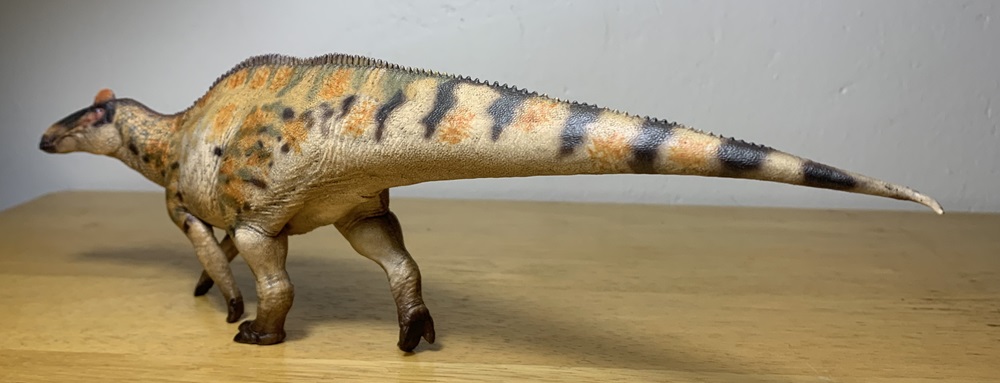
The figure is presented in a static, forward facing, quadrupedal walking pose. Like virtually all Haolonggood figures. I don’t really mind these poses, but I can empathize with collectors who would like to see more dynamism in these figures. Again, PNSO’s has that going for it. With this figure the head is looking slightly leftward, and the tail gently curves rightward. The tip of the tail has a little bend in it, I’m not sure if that’s intentional or warping. I quite like the figure’s posture and that’s part of what attracted me to it.

Although the head has the heavy brow and comb of E. regalis the skull shape is somewhat long and low for the species, which is why I think you could use it for either species. The beak is accurately shovel shaped with slight vertical grooves etched in the surface. Its downward projecting edge is supported by fossil evidence that does away with the “duck-billed” depictions of old that didn’t take the keratin sheath into account. No cheeks are present here, which is the look that seems to be in vogue these days.
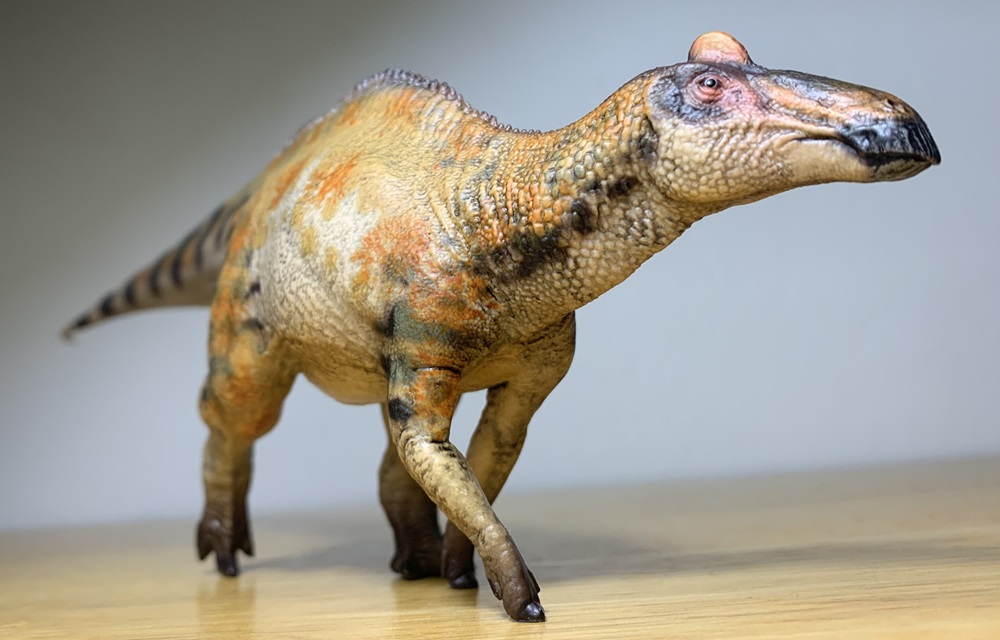
The neck is covered in a chain-like pattern of large scales that we also see in skin impressions. The rest of the body has a covering of accurately small pebbly scales that are virtually indecipherable in some places, as they should be at this scale. There are some larger patches in places, like on the lower jaw and upper thighs. A row of rectangular scutes runs down the back, from the nape to the end of the tail where they gradually get smaller until they vanish completely. The face is a focal point for a lot of fine detail including wrinkled eyelids, smooth nasal sacs, and scales encircling the nostrils.

Wrinkles and skin folds are abundant and organically placed, mostly along the neck, limb joints, and lower sides of the tail. The torso is rounded, bulging, and smooth with taught skin. Underlying anatomy includes a visible hump along the back that encases the neural spines and has faint grooves running down between the spines. The thighs are ample, and the calves are muscular. All bodily orifices are present, including ear holes and a cloaca.

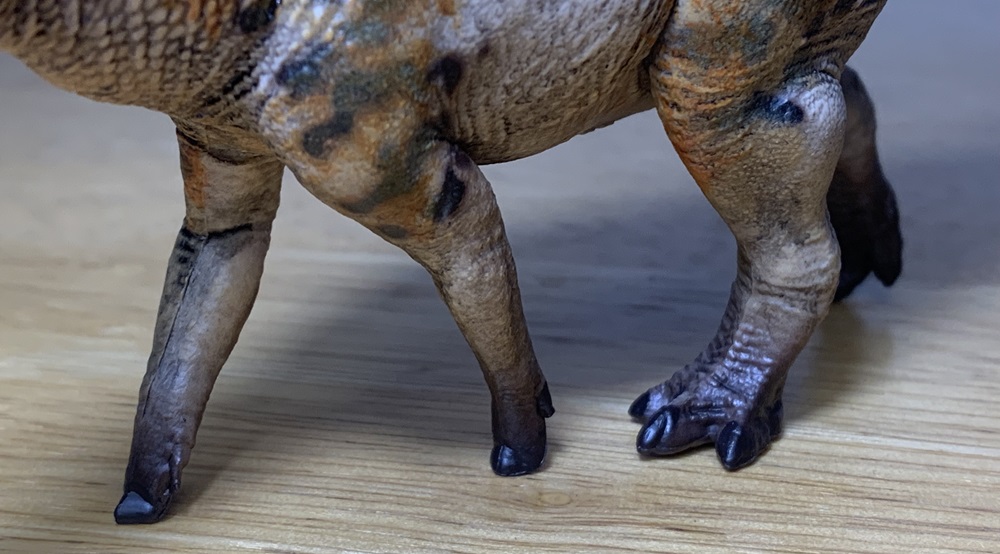
The forelimbs are dainty compared to the hindlimbs but still appear strong and muscular with protruding shoulders. The forelimbs are accurately rendered with digit 2 reduced to a small splint, digits 3 and 4 encased in a fleshy weight bearing mitt with one large nail supporting it, and digit 5 being reduced but still possessing a nail. The tail is laterally compressed and thickened along the base. The overall build adopts the thick look that’s currently trending for ornithopods, but I’ve seen thicker renditions, including PNSO’s.
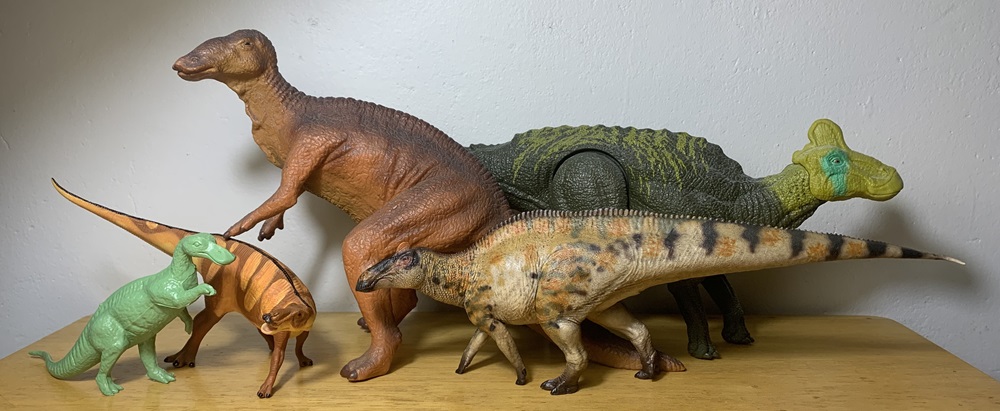
As usual, you have two color options with this figure. Orange and green, somewhat predictable options with Haolonggood. Both are attractive but I found the orange one less conventional. The paintjob is complex with a lot going on. The body is mostly tan with orange saddling the back. Dull green triangular bands along the back transition to black bands along the tail. Orange, black, and dull green splotches decorate the flanks, mostly on the neck, upper arms, and thighs. Orange splotches are painted between the black bands on the tail. Most of the lower torso, lower portions of the limbs, and underside are patternless. The hands and feet transition to dark brown.

Most of the cranium is black while the lower jaw is tan. Orange coloration encircles the nostrils, and the skin around the orbits is pink with black patterning swooping up, over, and behind the eyes. The eyes themselves are blue with black pupils. The comb is vibrant orange. Patterning on the green version is the same, the orange portions are just replaced with green, and the comb is blue. The contrast between colors appears stronger on the orange version, which is another reason why I picked it. I think the paintjob is fantastic overall and one of Haolonggood’s stronger efforts. This figure does not suffer from the flat and hazy looking paintjobs that some Haolonggood figures have and the blending of colors and paint application is top tier.

The Haolonggood Edmontosaurus is everything I wanted from an Edmontosaurus for my collection, it just nails how I envision this animal in my mind. PNSO’s does too and I initially planned to get (and review) it, but once this one was announced it bumped it off my shopping list. Yes, it is a bit smaller, but in my cramped cabinet space is precious. Price was also a factor, since PNSO’s cost twice as much as this one. Also, although PNSO’s is more dynamic, I prefer the color options on both of Haolonggood’s figures. Whatever your preference, you can’t go wrong with either figure and it’s nice to have options. Hopefully someone will step up and review the PNSO offering! The Haolonggood Edmontosaurus is currently available and retails for about $25.
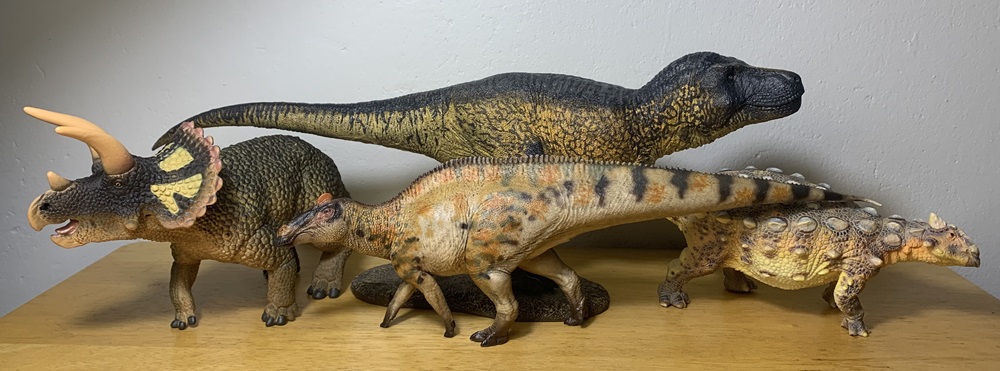
You can support the Dinosaur Toy Blog by making dino-purchases through these links to Ebay and Amazon. Disclaimer: these and other links to Ebay and Amazon on the Dinosaur Toy Blog are often affiliate links, so when you make purchases through them we may make a commission.

I own this model myself and I must say this AMAZING figure is more than satisfactory! 10/10 on every level possible!
Another impressive ornithopod from Haolonggood. I was prioritizing the more uncommon genera from the company, but I’ll definitely consider adding this one to the herd in the future.
Abosolutely STUNNING!!! Best Hadrosaur ever made by any company – I actually bought BOTH color versions.
This very paint scheme above inspired me to ‘bash my PNSO Shantungosaurus into a much larger version of this very Edmontosaur. (You can see it on the very last page of my dino gallery linked below).
Or just cut and paste this link into your browser:
https://bucketfoot-al.tripod.com/DinoModels/index.album/my-garage-kit-gallery?i=390
Great work! I guess your custom piece more than makes up for the small size of HLG’s.
Yes it does! ;>) Thank you.
Its colors make it kinda look like moldy cheese lol
Yeah, I can see that. lol
Thanks! I kind of wavered on Safari’s for a while, but then this one was announced and Safari’s was retired. It was meant to be.
I have this one and it’s the Edmontosaurus I have waited all my life for (and I’m 77)!
Oh wow, that’s a long wait! I’m glad it finally paid off!
Great Review, thanks Gwangi.
Finally the perfect Edmontosaurus for me. Collecta and Safari did make good ones too, but i did not like them as much to buy em. PNSO is completely out of my Interest zone with their Prices.
Body and even Paintjob look stunning and great to me. And man does this Figure look good next to the EoFauna T. rex.
What a fantastic Figure of an Endmontosaurus. And for a Price that feels more than fair.
Thanks! I agree about CollectA and Safari’s. They’re fine figures but just didn’t do it for me. Haolonggood’s does look great next to the Eofauna T. rex but it would look better if it was a little larger.
Wonderful review as always! Very nice figure, indeed, but I am content with Safari’s most recent version. If I didn’t have it, though, this would be my first choice. I never cared for CollectA’s either, and why pay double for PNSO?